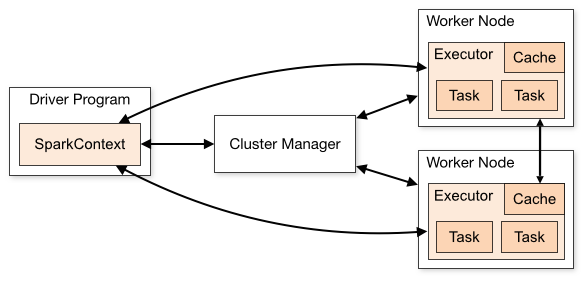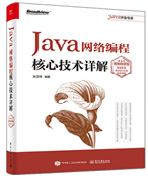|
|
demo2 Kafka+Spark Streaming+Redis实时计算整合实践
foreachRDD输出到redis 基于Spark通用计算平台,可以很好地扩展各种计算类型的应用,尤其是Spark提供了内建的计算库支持,像Spark Streaming、Spark SQL、MLlib、GraphX,这些内建库都提供了高级抽象,可以用非常简洁的代码实现复杂的计算逻辑、这也得益于Scala编程语言的简洁性。这里,我们基于1.3.0版本的Spark搭建了计算平台,实现基于Spark Streaming的实时计算。
我们的应用场景是分析用户使用手机App的行为,描述如下所示:
- 手机客户端会收集用户的行为事件(我们以点击事件为例),将数据发送到数据服务器,我们假设这里直接进入到Kafka消息队列
- 后端的实时服务会从Kafka消费数据,将数据读出来并进行实时分析,这里选择Spark Streaming,因为Spark Streaming提供了与Kafka整合的内置支持
- 经过Spark Streaming实时计算程序分析,将结果写入Redis,可以实时获取用户的行为数据,并可以导出进行离线综合统计分析
Spark Streaming介绍
Spark Streaming提供了一个叫做DStream(Discretized Stream)的高级抽象,DStream表示一个持续不断输入的数据流,可以基于Kafka、TCP Socket、Flume等输入数据流创建。在内部,一个DStream实际上是由一个RDD序列组成的。Sparking Streaming是基于Spark平台的,也就继承了Spark平台的各种特性,如容错(Fault-tolerant)、可扩展(Scalable)、高吞吐(High-throughput)等。
在Spark Streaming中,每个DStream包含了一个时间间隔之内的数据项的集合,我们可以理解为指定时间间隔之内的一个batch,每一个batch就构成一个RDD数据集,所以DStream就是一个个batch的有序序列,时间是连续的,按照时间间隔将数据流分割成一个个离散的RDD数据集,如图所示(来自官网):

我们都知道,Spark支持两种类型操作:Transformations和Actions。Transformation从一个已知的RDD数据集经过转换得到一个新的RDD数据集,这些Transformation操作包括map、filter、flatMap、union、join等,而且Transformation具有lazy的特性,调用这些操作并没有立刻执行对已知RDD数据集的计算操作,而是在调用了另一类型的Action操作才会真正地执行。Action执行,会真正地对RDD数据集进行操作,返回一个计算结果给Driver程序,或者没有返回结果,如将计算结果数据进行持久化,Action操作包括reduceByKey、count、foreach、collect等。关于Transformations和Actions更详细内容,可以查看官网文档。
同样、Spark Streaming提供了类似Spark的两种操作类型,分别为Transformations和Output操作,它们的操作对象是DStream,作用也和Spark类似:Transformation从一个已知的DStream经过转换得到一个新的DStream,而且Spark Streaming还额外增加了一类针对Window的操作,当然它也是Transformation,但是可以更灵活地控制DStream的大小(时间间隔大小、数据元素个数),例如window(windowLength, slideInterval)、countByWindow(windowLength, slideInterval)、reduceByWindow(func, windowLength, slideInterval)等。Spark Streaming的Output操作允许我们将DStream数据输出到一个外部的存储系统,如数据库或文件系统等,执行Output操作类似执行Spark的Action操作,使得该操作之前lazy的Transformation操作序列真正地执行。
Kafka+Spark Streaming+Redis编程实践
下面,我们根据上面提到的应用场景,来编程实现这个实时计算应用。
首先,创建一个scala工程,创建方法见 三、使用maven创建scala工程(scala和java混一起)
引入kafka、redis、json等相关的包,pom.xml 如下:
<? xml version="1.0" encoding="UTF-8" ?>
< project xmlns ="http://maven.apache.org/POM/4.0.0" xmlns:xsi ="http://www.w3.org/2001/XMLSchema-instance"
xsi:schemaLocation ="http://maven.apache.org/POM/4.0.0 http://maven.apache.org/maven-v4_0_0.xsd" >
< modelVersion >4.0.0 </ modelVersion >
< parent >
< artifactId >fvp </ artifactId >
< groupId >com.sf.fvp </ groupId >
< version >0.0.1-SNAPSHOT </ version >
</ parent >
< groupId >com.sf </ groupId >
< artifactId >scalademo3 </ artifactId >
< version >1.0-SNAPSHOT </ version >
< name >${project.artifactId} </ name >
< description >My wonderfull scala app </ description >
< inceptionYear >2015 </ inceptionYear >
< licenses >
< license >
< name >My License </ name >
< url >a%20href=http://.%20target=_blankspan%20class=topicHrefhttp://./span/a. </ url >
< distribution >repo </ distribution >
</ license >
</ licenses >
< properties >
< maven.compiler.source >1.6 </ maven.compiler.source >
< maven.compiler.target >1.6 </ maven.compiler.target >
< encoding >UTF-8 </ encoding >
< scala.version >2.11.5 </ scala.version >
< scala.compat.version >2.11 </ scala.compat.version >
</ properties >
< dependencies >
<!-- https://mvnrepository.com/artifact/org.apache.spark/spark-core_2.10 -->
< dependency >
< groupId >org.apache.spark </ groupId >
< artifactId >spark-core_2.11 </ artifactId >
< version >2.0.2 </ version >
</ dependency >
< dependency >
< groupId >org.apache.spark </ groupId >
< artifactId >spark-streaming_2.11 </ artifactId >
< version >2.0.2 </ version >
</ dependency >
< dependency >
< groupId >org.scala-lang </ groupId >
< artifactId >scala-library </ artifactId >
< version >${scala.version} </ version >
</ dependency >
< dependency >
< groupId >org.apache.spark </ groupId >
< artifactId >spark-streaming-kafka-0-8_2.11 </ artifactId >
< version >2.0.2 </ version >
</ dependency >
< dependency >
< groupId >net.sf.json-lib </ groupId >
< artifactId >json-lib </ artifactId >
< version >2.2.3 </ version >
</ dependency >
< dependency >
< groupId >org.codehaus.jettison </ groupId >
< artifactId >jettison </ artifactId >
< version >1.3.8 </ version >
</ dependency >
< dependency >
< groupId >net.sf.ezmorph </ groupId >
< artifactId >ezmorph </ artifactId >
< version >1.0.6 </ version >
</ dependency >
< dependency >
< groupId >redis.clients </ groupId >
< artifactId >jedis </ artifactId >
< version >2.5.2 </ version >
</ dependency >
< dependency >
< groupId >org.apache.commons </ groupId >
< artifactId >commons-pool2 </ artifactId >
< version >2.2 </ version >
</ dependency >
<!-- Test -->
< dependency >
< groupId >junit </ groupId >
< artifactId >junit </ artifactId >
< version >4.11 </ version >
< scope >test </ scope >
</ dependency >
< dependency >
< groupId >org.specs2 </ groupId >
< artifactId >specs2-core_${scala.compat.version} </ artifactId >
< version >2.4.16 </ version >
< scope >test </ scope >
</ dependency >
< dependency >
< groupId >org.scalatest </ groupId >
< artifactId >scalatest_${scala.compat.version} </ artifactId >
< version >2.2.4 </ version >
< scope >test </ scope >
</ dependency >
</ dependencies >
< build >
< sourceDirectory >src/main/scala </ sourceDirectory >
< testSourceDirectory >src/test/scala </ testSourceDirectory >
< plugins >
< plugin >
<!-- see http://davidb.github.com/scala-maven-plugin -->
< groupId >net.alchim31.maven </ groupId >
< artifactId >scala-maven-plugin </ artifactId >
< version >3.2.0 </ version >
< executions >
< execution >
< goals >
< goal >compile </ goal >
< goal >testCompile </ goal >
</ goals >
< configuration >
< args >
< arg >-make:transitive </ arg >
< arg >-dependencyfile </ arg >
< arg >${project.build.directory}/.scala_dependencies </ arg >
</ args >
</ configuration >
</ execution >
</ executions >
</ plugin >
< plugin >
< groupId >org.apache.maven.plugins </ groupId >
< artifactId >maven-surefire-plugin </ artifactId >
< version >2.18.1 </ version >
< configuration >
< useFile >false </ useFile >
< disableXmlReport >true </ disableXmlReport >
<!-- If you have classpath issue like NoDefClassError,... -->
<!-- useManifestOnlyJar>false</useManifestOnlyJar -->
< includes >
< include >**/*Test.* </ include >
< include >**/*Suite.* </ include >
</ includes >
</ configuration >
</ plugin >
</ plugins >
</ build >
</ project > |
二、写了一个Kafka Producer模拟程序,用来模拟向Kafka实时写入用户行为的事件数据,数据是JSON格式,示例如下:
{"uid":"068b746ed4620d25e26055a9f804385f","event_time":"1430204612405","os_type":"Android","click_count":6}
一个事件包含4个字段:
- uid:用户编号
- event_time:事件发生时间戳
- os_type:手机App操作系统类型
- click_count:点击次数
下面是我们实现的代码,如下所示:
package com.sf.scalademo3
import java.util.Properties
import scala.util.Properties
import org.codehaus.jettison.json.JSONObject
import kafka.javaapi.producer.Producer
import kafka.producer.KeyedMessage
import kafka.producer.KeyedMessage
import kafka.producer.ProducerConfig
import scala.util.Random
object KafkaEventProducer {
private val users = Array(
"4A4D769EB9679C054DE81B973ED5D768", "8dfeb5aaafc027d89349ac9a20b3930f" ,
"011BBF43B89BFBF266C865DF0397AA71", "f2a8474bf7bd94f0aabbd4cdd2c06dcf" ,
"068b746ed4620d25e26055a9f804385f", "97edfc08311c70143401745a03a50706" ,
"d7f141563005d1b5d0d3dd30138f3f62", "c8ee90aade1671a21336c721512b817a" ,
"6b67c8c700427dee7552f81f3228c927", "a95f22eabc4fd4b580c011a3161a9d9d" )
private val random = new Random()
private var pointer = -1
def getUserID(): String = {
pointer = pointer + 1
if (pointer >= users.length) {
pointer = 0
users(pointer)
} else {
users(pointer)
}
}
def click(): Double = {
random.nextInt(10 )
}
// bin/kafka-topics.sh --zookeeper zk1:2181,zk2:2181,zk3:2181/kafka --create --topic user_events --replication-factor 2 --partitions 2
// bin/kafka-topics.sh --zookeeper zk1:2181,zk2:2181,zk3:2181/kafka --list
// bin/kafka-topics.sh --zookeeper zk1:2181,zk2:2181,zk3:2181/kafka --describe user_events
// bin/kafka-console-consumer.sh --zookeeper zk1:2181,zk2:2181,zk3:22181/kafka --topic test_json_basis_event --from-beginning
def main(args: Array[String]): Unit = {
val topic = "user_events"
val brokers = "localhost:9092"
val props = new Properties()
props.put("metadata.broker.list" , brokers)
props.put("serializer.class", "kafka.serializer.StringEncoder" )
val kafkaConfig = new ProducerConfig(props)
val producer = new Producer[String, String](kafkaConfig)
while ( true ) {
// prepare event data
val event = new JSONObject()
event
.put("uid" , getUserID)
.put("event_time" , System.currentTimeMillis.toString)
.put("os_type", "Android" )
.put("click_count" , click)
// produce event message
producer.send( new KeyedMessage[String, String](topic, event.toString))
println("Message sent: " + event)
Thread.sleep(200 )
}
}
} |
通过控制上面程序最后一行的时间间隔来控制模拟写入速度。
三、下面我们来讨论实现实时统计每个用户的点击次数,它是按照用户分组进行累加次数,逻辑比较简单,关键是在实现过程中要注意一些问题,如对象序列化等。先看实现代码,稍后我们再详细讨论,代码实现如下所示:
package com.sf.scalademo3
import kafka.serializer.StringDecoder
import org.apache.spark.SparkConf
import org.apache.spark.streaming._
import org.apache.spark.streaming.kafka.KafkaUtils
import net.sf.json.JSONObject
import redis.clients.jedis.JedisPool
import org.apache.commons.pool2.impl.GenericObjectPoolConfig
object UserClickCountAnalytics {
def main(args: Array[String]): Unit = {
var masterUrl = "local[1]"
if (args.length > 0 ) {
masterUrl = args(0 )
}
// Create a StreamingContext with the given master URL
val conf = new SparkConf().setMaster(masterUrl).setAppName("UserClickCountStat" )
val ssc = new StreamingContext(conf, Seconds(5 ))
// Kafka configurations
val topics = Set("user_events" )
val brokers = "localhost:9092"
val kafkaParams = Map[String, String](
"metadata.broker.list" -> brokers, "serializer.class" -> "kafka.serializer.StringEncoder" )
val dbIndex = 1
val clickHashKey = "app::users::click"
// Create a direct stream
val kafkaStream = KafkaUtils.createDirectStream[String, String, StringDecoder, StringDecoder](ssc, kafkaParams, topics)
val events = kafkaStream.flatMap(line => {
val data = JSONObject.fromObject(line._2)
Some(data)
})
// Compute user click times
val userClicks = events.map(x => (x.getString("uid"), x.getInt("click_count"))).reduceByKey(_ + _)
userClicks.foreachRDD(rdd => {
rdd.foreachPartition(partitionOfRecords => {
partitionOfRecords.foreach(pair => {
val uid = pair._1
val clickCount = pair._2
val jedis = RedisClient.pool.getResource
jedis.select(dbIndex)
jedis.hincrBy(clickHashKey, uid, clickCount)
RedisClient.pool.returnResource(jedis)
})
})
})
ssc.start()
ssc.awaitTermination()
}
}
上面代码使用了Jedis客户端来操作Redis,将分组计数结果数据累加写入Redis存储,如果其他系统需要实时获取该数据,直接从Redis实时读取即可。RedisClient实现代码如下所示:
package com.sf.scalademo3
import redis.clients.jedis.JedisPool
import org.apache.commons.pool2.impl.GenericObjectPoolConfig
object RedisClient extends Serializable {
val redisHost = "10.202.34.232"
val redisPort = 6383
val redisTimeout = 30000
lazy val pool = new JedisPool( new GenericObjectPoolConfig(), redisHost, redisPort, redisTimeout)
lazy val hook = new Thread {
override def run = {
println("Execute hook thread: " + this )
pool.destroy()
}
}
sys.addShutdownHook(hook.run)
} |
上面代码我们分别在local[K]和Spark Standalone集群模式下运行通过。
如果我们是在开发环境进行调试的时候,也就是使用local[K]部署模式,在本地启动K个Worker线程来计算,这K个Worker在同一个JVM实例里,上面的代码默认情况是,如果没有传参数则是local[K]模式,所以如果使用这种方式在创建Redis连接池或连接的时候,可能非常容易调试通过,但是在使用Spark Standalone、YARN Client(YARN Cluster)或Mesos集群部署模式的时候,就会报错,主要是由于在处理Redis连接池或连接的时候出错了。我们可以看一下Spark架构,如图所示(来自官网):

无论是在本地模式、Standalone模式,还是在Mesos或YARN模式下,整个Spark集群的结构都可以用上图抽象表示,只是各个组件的运行环境不同,导致组件可能是分布式的,或本地的,或单个JVM实例的。如在本地模式,则上图表现为在同一节点上的单个进程之内的多个组件;而在YARN Client模式下,Driver程序是在YARN集群之外的一个节点上提交Spark Application,其他的组件都运行在YARN集群管理的节点上。
在Spark集群环境部署Application后,在进行计算的时候会将作用于RDD数据集上的函数(Functions)发送到集群中Worker上的Executor上(在Spark Streaming中是作用于DStream的操作),那么这些函数操作所作用的对象(Elements)必须是可序列化的,通过Scala也可以使用lazy引用来解决,否则这些对象(Elements)在跨节点序列化传输后,无法正确地执行反序列化重构成实际可用的对象。上面代码我们使用lazy引用(Lazy Reference)来实现的,代码如下所示:
package com.sf.scalademo3
import org.apache.commons.pool2.impl.GenericObjectPoolConfig
import org.apache.spark.SparkConf
import org.apache.spark.streaming.Seconds
import org.apache.spark.streaming.StreamingContext
import org.apache.spark.streaming.dstream.DStream.toPairDStreamFunctions
import org.apache.spark.streaming.kafka.KafkaUtils
import kafka.serializer.StringDecoder
import net.sf.json.JSONObject
import redis.clients.jedis.JedisPool
object UserClickCountAnalytics2 {
def main(args: Array[String]): Unit = {
var masterUrl = "local[1]"
if (args.length > 0 ) {
masterUrl = args(0 )
}
// Create a StreamingContext with the given master URL
val conf = new SparkConf().setMaster(masterUrl).setAppName("UserClickCountStat" )
val ssc = new StreamingContext(conf, Seconds(5 ))
// Kafka configurations
val topics = Set("user_events" )
val brokers = "localhost:9092"
val kafkaParams = Map[String, String](
"metadata.broker.list" -> brokers, "serializer.class" -> "kafka.serializer.StringEncoder" )
val dbIndex = 1
val clickHashKey = "app::users::click"
// Create a direct stream
val kafkaStream = KafkaUtils.createDirectStream[String, String, StringDecoder, StringDecoder](ssc, kafkaParams, topics)
val events = kafkaStream.flatMap(line => {
val data = JSONObject.fromObject(line._2)
Some(data)
})
// Compute user click times
val userClicks = events.map(x => (x.getString("uid"), x.getInt("click_count"))).reduceByKey(_ + _)
userClicks.foreachRDD(rdd => {
rdd.foreachPartition(partitionOfRecords => {
partitionOfRecords.foreach(pair => {
/**
* Internal Redis client for managing Redis connection { @link Jedis} based on { @link RedisPool}
*/
object InternalRedisClient extends Serializable {
@ transient private var pool: JedisPool = null
def makePool(redisHost: String, redisPort: Int, redisTimeout: Int,
maxTotal: Int, maxIdle: Int, minIdle: Int): Unit = {
makePool(redisHost, redisPort, redisTimeout, maxTotal, maxIdle, minIdle, true, false, 10000 )
}
def makePool(redisHost: String, redisPort: Int, redisTimeout: Int,
maxTotal: Int, maxIdle: Int, minIdle: Int, testOnBorrow: Boolean,
testOnReturn: Boolean, maxWaitMillis: Long): Unit = {
if (pool == null ) {
val poolConfig = new GenericObjectPoolConfig()
poolConfig.setMaxTotal(maxTotal)
poolConfig.setMaxIdle(maxIdle)
poolConfig.setMinIdle(minIdle)
poolConfig.setTestOnBorrow(testOnBorrow)
poolConfig.setTestOnReturn(testOnReturn)
poolConfig.setMaxWaitMillis(maxWaitMillis)
pool = new JedisPool(poolConfig, redisHost, redisPort, redisTimeout)
val hook = new Thread {
override def run = pool.destroy()
}
sys.addShutdownHook(hook.run)
}
}
def getPool: JedisPool = {
assert(pool != null )
pool
}
}
// Redis configurations
val maxTotal = 10
val maxIdle = 10
val minIdle = 1
val redisHost = "10.202.34.232"
val redisPort = 6383
val redisTimeout = 30000
val dbIndex = 1
InternalRedisClient.makePool(redisHost, redisPort, redisTimeout, maxTotal, maxIdle, minIdle)
val uid = pair._1
val clickCount = pair._2
val jedis = InternalRedisClient.getPool.getResource
jedis.select(dbIndex)
// 原子操作--Redis HINCRBY命令用于增加存储在字段中存储由增量键哈希的数量。
// 如果键不存在,新的key被哈希创建。如果字段不存在,值被设置为0之前进行操作。
jedis.hincrBy(clickHashKey, uid, clickCount)
InternalRedisClient.getPool.returnResource(jedis)
})
})
})
ssc.start()
ssc.awaitTermination()
}
} |
上面代码实现,得益于Scala语言的特性,可以在代码中任何位置进行class或object的定义,我们将用来管理Redis连接的代码放在了特定操作的内部,就避免了瞬态(Transient)对象跨节点序列化的问题。这样做还要求我们能够了解Spark内部是如何操作RDD数据集的,更多可以参考RDD或Spark相关文档。
在集群上,以Standalone模式运行,执行如下命令:
cd /usr/local/ spark
2 ./bin/spark-submit -- class org.shirdrn.spark.streaming.UserClickCountAnalytics --master spark: // hadoop1:7077 --executor-memory 1G --total-executor-cores 2 ~/spark-0.0.SNAPSHOT.jar spark: // hadoop1:7077
可以查看集群中各个Worker节点执行计算任务的状态,也可以非常方便地通过Web页面查看。
下面,看一下我们存储到Redis中的计算结果,如下所示:

有关更多关于Spark Streaming的详细内容,可以参考官方文档。
附录
这里,附上前面开发的应用所对应的依赖,以及打包Spark Streaming应用程序的Maven配置,以供参考。如果使用maven-shade-plugin插件,配置有问题的话,打包后在Spark集群上提交Application时候可能会报错Invalid signature file digest for Manifest main attributes。
转自:http://shiyanjun.cn/archives/1097.html
----------------------------
原文链接:https://blog.csdn.net/weixin_34416754/article/details/85609492
程序猿的技术大观园:www.javathinker.net
[这个贴子最后由 flybird 在 2020-03-22 10:15:17 重新编辑]
|
|

















